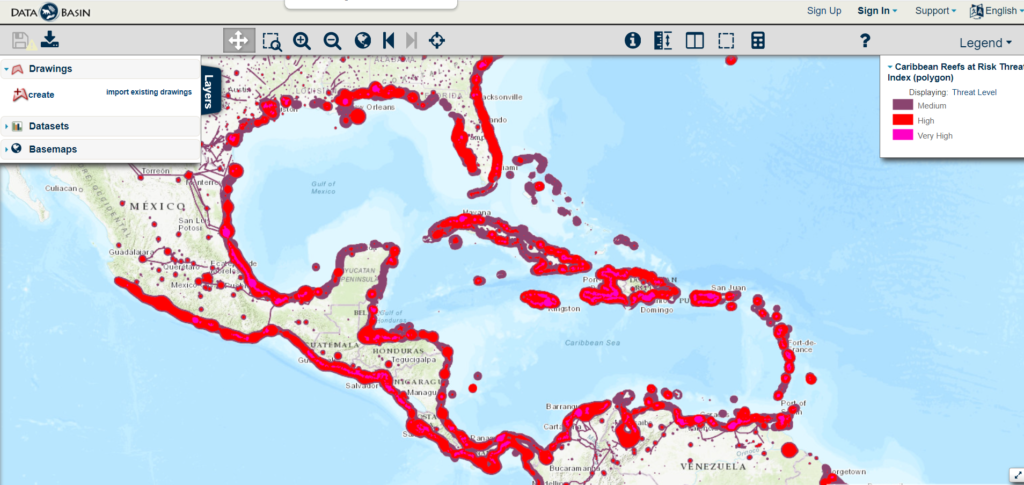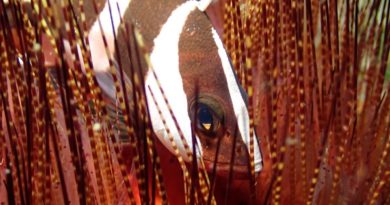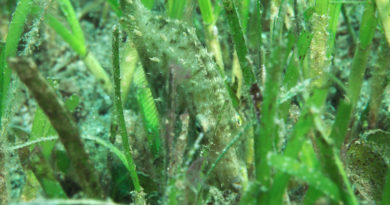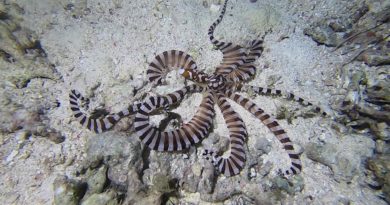Thoughts on the Invasive Lionfish
If you are a scuba diver who frequents the Caribbean, it will not be news to you that the region is being invaded by lionfish. “Invaded” sounds anthropomorphizing, but is in fact the correct term: The lionfish are an invasive species, meaning that the species evolved in another part of the world – the Pacific Ocean in the case of the lionfish – and was brought to its new home by humans, where it spread quickly, and often at the cost of the native fauna and flora. Examples of invasive species are plenty in the 21st century, both on land as well as in the ocean and in freshwater, as well as from the realm of plants and animals.
I live in the Philippines, which still is a fantastic place for a nature lover, but nevertheless the islands have been pested by a variety of invasive species, from the cane toads which are famously infesting the wet tropics of Australia to a variety of freshwater fishes. We have lionfish, too, BUT they are not invasive here, they are native to the area’s reefs. I encounter them on and off on dives, and the question why they are a part of the ecosystem here, with populations kept in check by parasites and predators, but are out of control in the Caribbean.
In brief, the first lionfish in the Caribbean were observed in 1985, almost certainly released from aquaria. They are pretty fish, popular with the marine water aquarium hobbyists. The spread across the Caribbean only took a few years, and the projected area which the lionfish will invade – based on currents and sea surface temperatures. The whole tropical and subtropical coast of South America will be covered!
To be precise, not THE lionfish, but two species are invading the Caribbean, Pterois volitans, and Pterois miles from the Indian Ocean.

Excellent map of lionfish ranges by the USGS.
A few things stand out: The density of lionfish in the Caribbean is 17 times the density compared to their native range! Removal efforts have made some local progress in reducing the lionfish numbers. It’s an uphill battle. Lionfish seem to have spread also vertically, to greater depths. In the video below, a lionfish hunts newly described gobies at 100+ meters.
I think a few factors played a role in the enormously fast expansion of lionfish into the Caribbean:
Typical Invasive Species Profile
The lionfish reproduces fast, is a food generalist and mid-sized. This seems to be an ideal pattern for a species to become invasive, with body size typically small to mid-sized, with the water buffaloes and camels in northern Australia some of the few examples of large invasives. Australia on land is an extreme example, it seems the continent’s ecosystem with its archaic marsupial fauna is especially vulnerable to invasions of eutherian mammals.
A larger fish would not have become popular with aquarium keepers, and not been moved to a new part of the world with such ease. Smaller animals on average also have larger populations, which makes it easier for them to quickly adapt evolutionarily to new habitats.
Add to that the venomous spines which make the lionfish inedible to a lot of predators, and they are close to the ideal invasive species.
Small beats Large in Ecosystem Battles
There seems to be a trend in species invasions – the invaders come from larger, more complex ecosystems and invade the smaller, less complex ecosystems. Redundancy of function fulfilled by a greater number of species buffers an ecosystem against instabilities (Biggs et al., 2020). Species from continental faunae much more often invade islands than the other way around. Large continental faunae invade the fauna of a smaller continent (Australia). The Caribbean is smaller as a marine biogeographic area than the Indo-Pacific. It’s just natural that an Indo-Pacific species would invade the Caribbean, not the other way around.
Unusual Swimming Behavior
Behavior has the primacy in evolution. The way the lionfish swims is probably rooted in a few causes. It’s not going to be a fast swimmer with these long, venomous spines it carries to defend itself. It swims in such a stealth, unusual way that it probably doesn’t trigger the usual “predator alert” pattern recognition in the visual and lateral-line brain areas of its prey. It is a very unusual fish in its locomotion compared to a lot of other medium-sized predators (please see the video below). This made it particularly hard for the larger potential predators in the Caribbean to recognize this new prey.
The Reefs in the Caribbean are Degraded
The lionfish did not encounter healthy, intact coral reefs when its first individuals were released in the 80s. Rather, they found themselves in sick or very sick ones.
 Another excellent map, this time from the World Resources Institute.
Another excellent map, this time from the World Resources Institute.
If you look at the legend in the top right corner, brown/red are medium threatened reefs, red are highly threatened reefs (most of the Caribbean!!) and pink indicates a very high threat level. The threat level is a measure compiled from coastal degradation (“development”), and overfishing.
This is a popular science article about the mass die-off of sea urchins in the Caribbean I wrote for “Die Furche”. You’ll have to be able to read German to read it, which is something I recommend anyway.
The Caribbean ocean was sick when the lionfish arrived, and just like you can catch a cold easier when you are already weakened by other health problems or stress, a species invasion will progress more crassly in an already weakened ecosystem. Mumby et al. (2011) state that groupers would eat lionfish in principle but “Thus, chronic overfishing will probably prevent natural biocontrol of lionfishes in the Caribbean.”
Mass Extinction Anyone?
The profile of a successful invasive species is somewhat reminiscent of the profile of a species which thrive after mass extinctions. I am not aware how or if this connection has been developed in biological thought, am am working my way through the literature, but the commonalities are striking.
After the absolutely devastating end-Permian extinction, for a few 100k years most large land animals were one species of Lystrosaurus, a medium sized herbivore. A combination of ecological parameters made this animal thrive in a depauperate, rapidly changing world. Any guesses who the Lystrosaurus of the oceans of the sixth mass extinction could be?
References
Biggs, C. R., Yeager, L. A., Bolser, D. G., Bonsell, C., Dichiera, A. M., Hou, Z., … & Erisman, B. E. (2020). Does functional redundancy affect ecological stability and resilience? A review and meta‐analysis. Ecosphere, 11(7), e03184.
Green, S. J., Akins, J. L., Maljković, A., & Côté, I. M. (2012). Invasive lionfish drive Atlantic coral reef fish declines. PloS one, 7(3), e32596.
The Flower Garden Banks National Marine Sanctuary has an informative page about the lionfish invasion.
Morris, J. A. Jr. The Biology and Ecology of the Invasive Indo-Pacific Lionfish. Thesis. (Under the direction of James A. Rice and John J. Govoni.)
Morris, J. A., & Akins, J. L. (2009). Feeding ecology of invasive lionfish (Pterois volitans) in the Bahamian archipelago. Environmental Biology of Fishes, 86(3), 389-398.
Mumby, P. J., Harborne, A. R., & Brumbaugh, D. R. (2011). Grouper as a natural biocontrol of invasive lionfish. PloS one, 6(6), e21510.
Video
Finally, I managed to get some really nice footage of lionfish lately, here in the Philippines, hovering, sometimes, in groups, and throwing hungry looks at small fish. Check it out:




